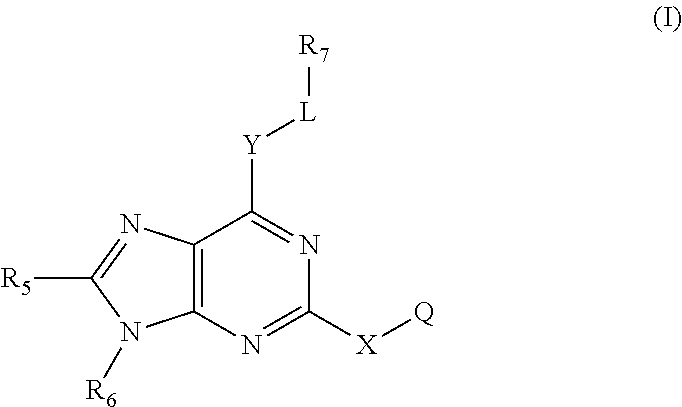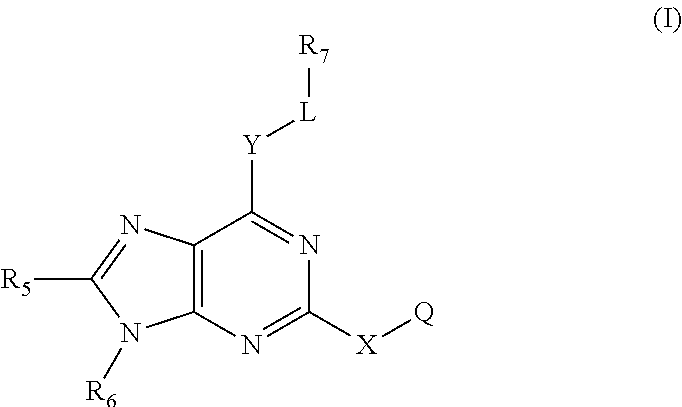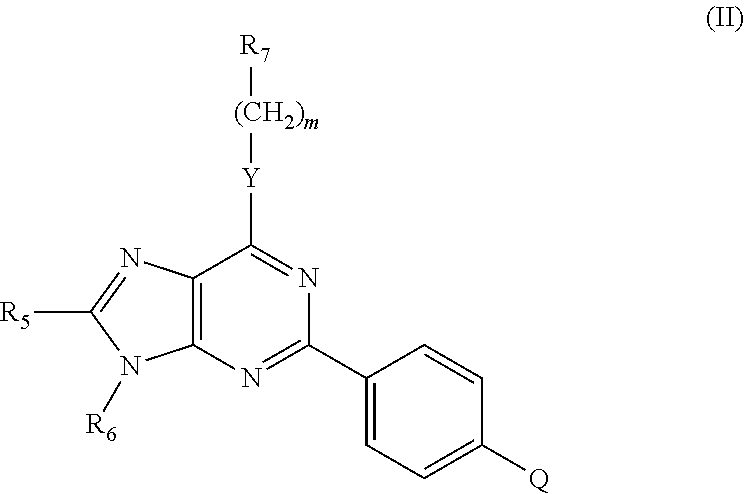Immune system modulators
a technology of immune system and modulator, applied in the field of immunology, can solve the problems of protective or adverse physiologic outcomes of the hos
- Summary
- Abstract
- Description
- Claims
- Application Information
AI Technical Summary
Problems solved by technology
Method used
Image
Examples
example 1
[0617]
[0618]A mixture of 5-aminoimidazole-4-carboxamide (12.6 gm, 0.10 moles), N-methyl-N′-(4-formylphenyl)piperazine (20.4 gm, 0.10 moles), sodium metabisulfite (14.3 gm, 0.075 moles) and water (1.4 mL) in dimethylacetamide (150 mL) was heated at 150° C. with stirring for 2 hours. The heat was removed and water (300 mL) was cautiously added. The resulting brown solution was then cooled in an ice bath with stirring. The solid which separated was isolated by filtration, washed with water and dried. TLC (silica, 25% methanol in methylene chloride) showed the presence of two products; a bright yellow compound with rf=0.42 and a colorless, blue fluorescent compound with rf=0.20. The total yield was 5.0 gm.
[0619]The crude product was dissolved in 30% methanol in chloroform (200 mL) and silica gel (75 gm) was added. This mixture was stripped of solvent under vacuum to give the product mixture adsorbed to silica. This material was deposited on top of a silica column (18 in×2 in). The colum...
example 54
[0623]
[0624]A mixture of 5-aminoimidazole-4-carboxamide (6.3 gm, 0.05 moles), N-ethyl-N′-(4-formylphenyl)piperazine (10.9 gm, 0.05 moles), sodium metabisulfite (7.13 gm, 0.037 moles) and water (675 μL) in dimethylacetamide (75 mL) was heated at 150° C. with stirring for 90 minutes. The heat was removed and water (150 mL) was cautiously added. The resulting brown solution was then cooled in an ice bath with stirring. The solid which separated was isolated by filtration, washed with water and dried. TLC (silica, 25% methanol in methylene chloride) showed the presence of two products; a bright yellow compound with rf=0.48 and a colorless, blue fluorescent compound with rf=0.25. The total yield was 2.4 gm.
[0625]The crude product was dissolved in 20% methanol in chloroform (200 mL) and silica gel (25 gm) was added. This mixture was stripped of solvent under vacuum to give the product mixture adsorbed to silica. This material was deposited on top of a silica column (18 in×2 in). The colum...
example 55
[0628]
[0629]A solution of 2,4-dichloropurine (1.0 gm, 5.3×10−3 moles) and ethyl bromoacetate (1.67 gm, 1.0×10−3 moles) in tetrahydrofuran (5 mL) was treated with a solution of tetrabutylammonium fluoride (10 mL, 1.0M, 1.0×10−2 moles). After stirring for 30 minutes a TLC (silica, 10% methanol in methylene chloride) showed that the starting material (Rf=0.38) had been cleanly converted to a single product (Rf=0.74). The reaction was diluted in diethyl ether (100 mL) and this solution was washed with water (2×50 mL). After drying over magnesium sulfate, the solution was filtered to remove the drying agent and the filtrates were evaporated under vacuum. The solid white residue was recrystallized from ethyl acetate (5 mL) and hexane (20 mL) to give the crystalline product in a yield of 0.95 gm (65.2%).
[0630]
[0631]The carboethoxypurine (0.95 gm, 3.45×10−3 moles) and N-2-aminoethylmorpholine (583 mg, 5884, 4.48×10−3 moles) were combined in 2-methyltetrahydrofuran (10 mL) and 2-propanol (3 ...
PUM
| Property | Measurement | Unit |
|---|---|---|
| temperature | aaaaa | aaaaa |
| structure | aaaaa | aaaaa |
| size | aaaaa | aaaaa |
Abstract
Description
Claims
Application Information
 Login to View More
Login to View More - R&D
- Intellectual Property
- Life Sciences
- Materials
- Tech Scout
- Unparalleled Data Quality
- Higher Quality Content
- 60% Fewer Hallucinations
Browse by: Latest US Patents, China's latest patents, Technical Efficacy Thesaurus, Application Domain, Technology Topic, Popular Technical Reports.
© 2025 PatSnap. All rights reserved.Legal|Privacy policy|Modern Slavery Act Transparency Statement|Sitemap|About US| Contact US: help@patsnap.com



